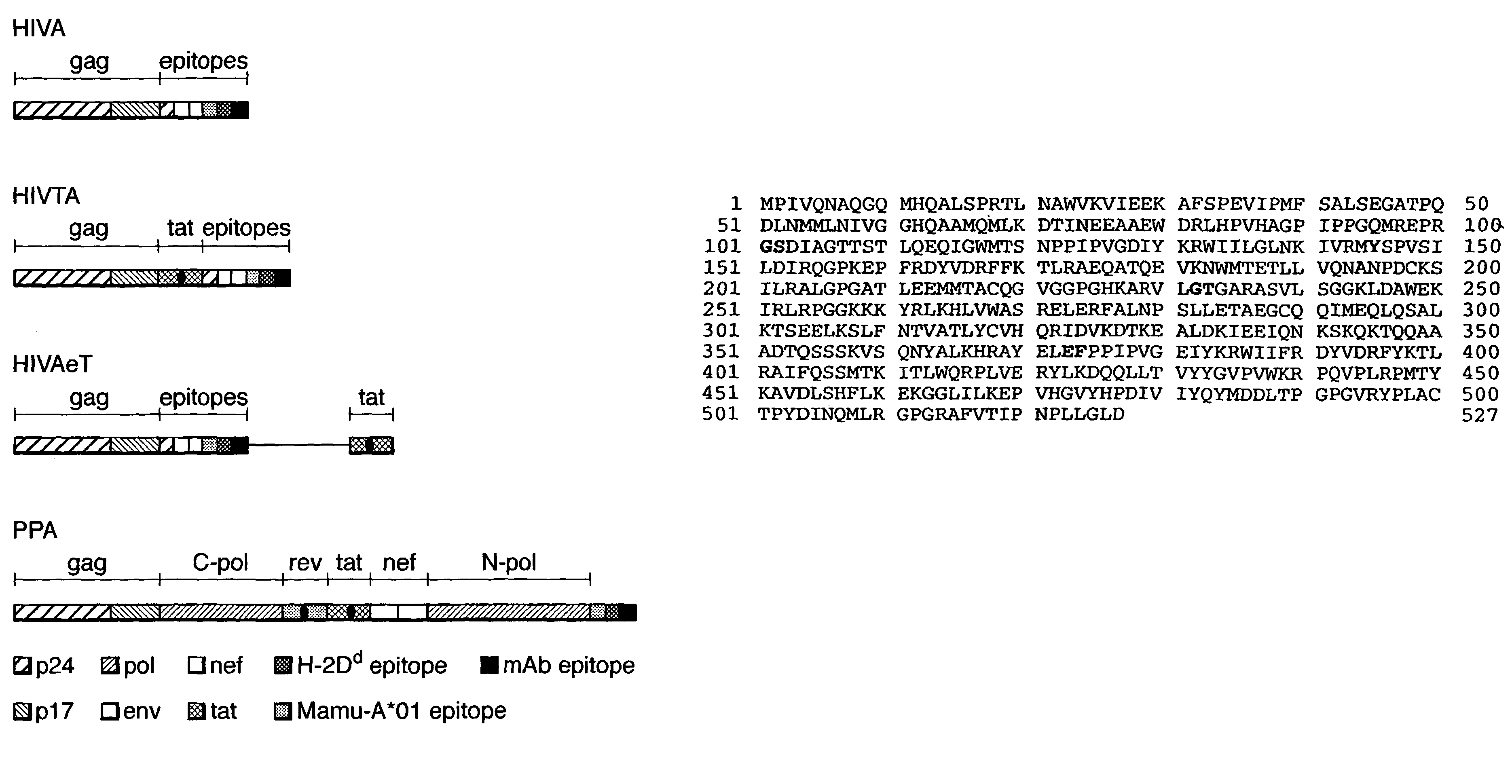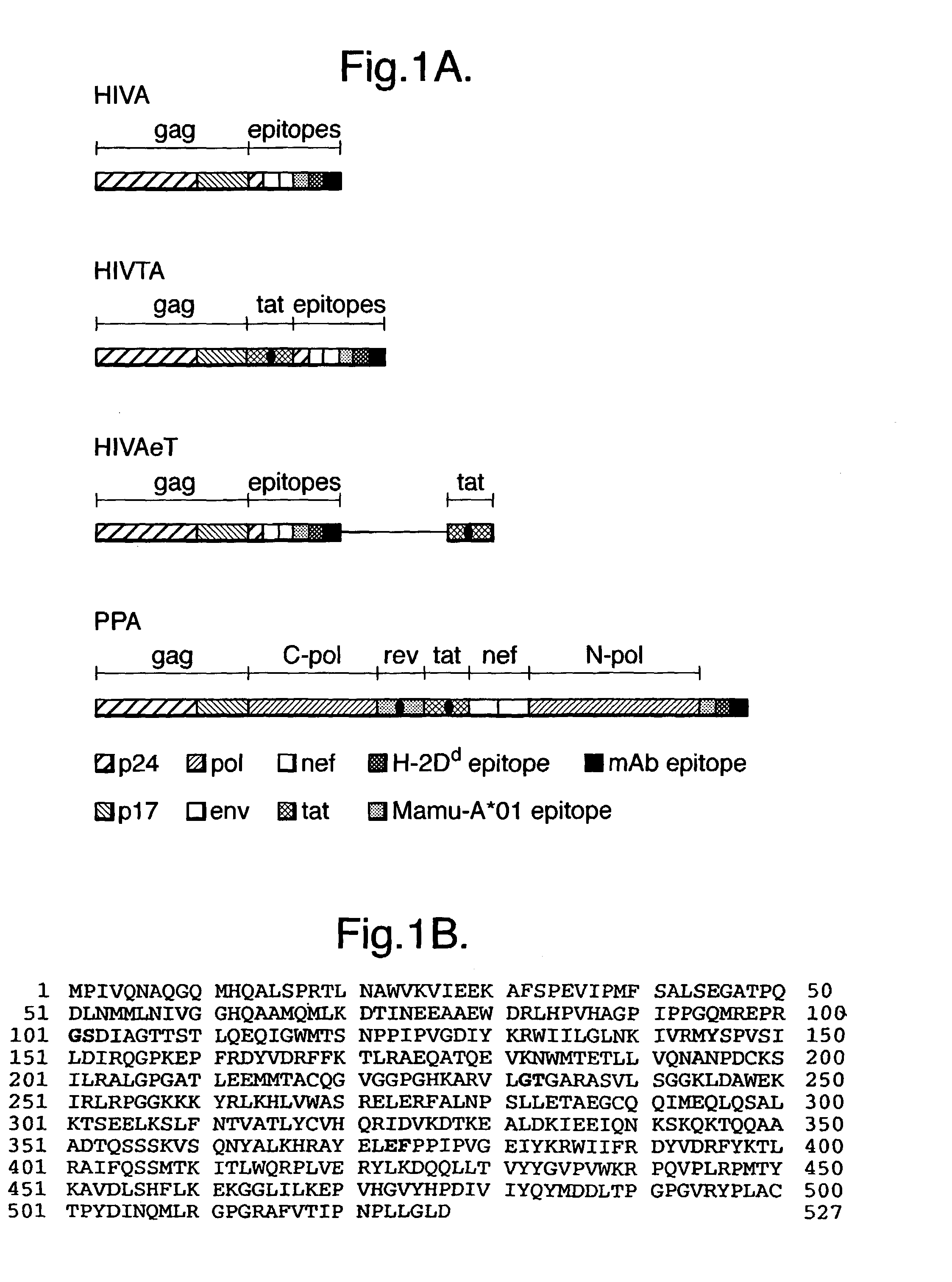Chimeric human immunodeficiency virus (HIV) immunogens comprising GAG P24-P17 fused to multiple cytotoxic T lymphocyte (CTL) epitopes
a human immunodeficiency virus and immunogen technology, applied in the field of immunogens, can solve the problems of unfavorable clinical trials, unfavorable clinical trials, and unrealistic objectives, and achieve the effects of exceedingly difficult, not immediately applicable or affordable, and reducing the number of patients
- Summary
- Abstract
- Description
- Claims
- Application Information
AI Technical Summary
Benefits of technology
Problems solved by technology
Method used
Image
Examples
example 1
[0064]This example relates to an immunogen for use in a vaccine focusing on the induction of cellular immune responses mediated by a concerted action of CD4+ helper and CD8+ effector T lymphocytes. The immunogen, designated HIVA (Hanke & McMichael Nat. Med. 6, 951-955), was designed for a phase III efficacy trial in Nairobi, Kenya. FIG. 1A is a schematic representation of several immunogens, including HIVA. HIVA is derived from the sequences of HIV-1 clade A, the predominant HIV clade in Nairobi and consists of about 73% of the gag protein fused to a string of 25 partially overlapping CTL epitopes. The gag domain of HIVA contains p24 and p17 in an order reversed to the viral gag p17-p24-p15 polyprotein. This rearrangement prevents myristylation of the N-terminus of p17, which could direct the recombinant protein to the cell membrane, thus preventing efficient degradation into peptides necessary for the major histocompatibility complex (MHC) class I presentation.
[0065]FIG. 1B shows t...
example 2
[0082]Further nucleic acid constructs were prepared which encoded polyprotein immunogens based on HIVA, but comprising further HIV antigen components. These further constructs and their encoded immunogens were termed HIVTA and HIVAeT, as shown in FIG. 1A. Also shown is a construct / immunogen termed PPA. The relevant DNA / amino acid sequences are shown in FIGS. 6 A / B-8 A / B respectively, although FIG. 7A shows only that portion of amino acid sequence in HIVA eT (attributable to tat) which is additional to that in HIVTA. (Note that the sequence of the HindIII and XbaI sites at the 5′ and 3′ ends of the DNA sequences are not shown in FIGS. 6B, 7B and 8B). The constructs were prepared in a manner similar to that described above for HIVA.
[0083]HIVTA and HIVAeT share the same design rationale with HIVA, but additionally include the HIV-1 clade A tat sequence, expressed either as part of a fusion protein with gag and the polyepitopic synthetic polypeptide (in the case of HIVTA, the tat sequen...
PUM
| Property | Measurement | Unit |
|---|---|---|
| Fraction | aaaaa | aaaaa |
| Current | aaaaa | aaaaa |
| Digital information | aaaaa | aaaaa |
Abstract
Description
Claims
Application Information
 Login to View More
Login to View More - R&D
- Intellectual Property
- Life Sciences
- Materials
- Tech Scout
- Unparalleled Data Quality
- Higher Quality Content
- 60% Fewer Hallucinations
Browse by: Latest US Patents, China's latest patents, Technical Efficacy Thesaurus, Application Domain, Technology Topic, Popular Technical Reports.
© 2025 PatSnap. All rights reserved.Legal|Privacy policy|Modern Slavery Act Transparency Statement|Sitemap|About US| Contact US: help@patsnap.com



